EMT Chapter 10 Airway management, Artificial Ventilation, and Oxygenation – Flashcards
Unlock all answers in this set
Unlock answersquestion
Respiration
answer
The gas exchange process that occurs between the alveoli or cells and the capillaries
question
Four distinct components of respiration
answer
1) pulmonary ventilation 2) external respiration 3) internal respiration 4) cellular respiration and metabolism
question
Pulmonary ventilation
answer
the mechanical process of moving air in and out of the lungs
question
External respiration
answer
the gas exchange process that occurs between the alveoli and the surrounding pulmonary capillaries; serves to oxygenate the blood and eliminate carbon dioxide in the lungs
question
Internal respiration
answer
cell/capillary gas exchange; is responsible for delivering oxygen to the cells and removing carbon dioxide from the cell
question
Cellular respiration and metabolism
answer
Breaks down glucose in the presence of oxygen, produces high amounts of energy in the form of ATP, and releases carbon dioxide and water as a by-product
question
The upper airway
answer
Nasal cavity, Nasopharynx, Oropharynx, Hypopharynx (laryngopharynx), epiglottis, esophagus, trachea, and larynx
question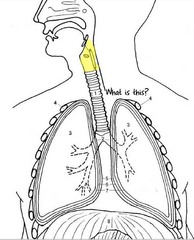
Pharynx

answer
Throat
question
Nasopharynx
answer
Where air from the nasal passages enter
question
Oropharynx
answer
Where air from the mouth travels to get to the lungs
question
Importance of keeping a clear pharynx
answer
Obstructions can prevent air from traveling into the lower airways or the substance may be aspirated into the lungs.
question
The two passageways found at the lower end of the pharynx
answer
The trachea and the esophagus
question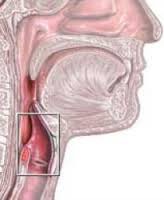
Larynx

answer
Above the trachea and below the epiglottis; the voice box
question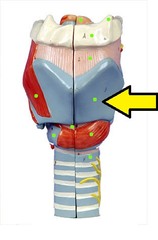
Thyroid cartilage

answer
the anterior portion of the larynx; the adams apple
question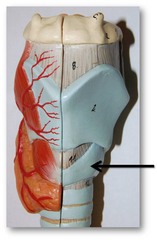
Cricoid cartilage

answer
the inferior portion of the larynx; the only completely circular cartilaginous ring of the upper airway
question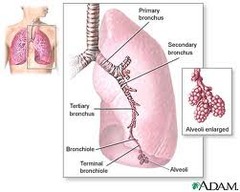
The lower airway

answer
From the cricoid cartilage to the alveoli
question
Trachea
answer
The windpipe; the passageway for air entering the lungs
question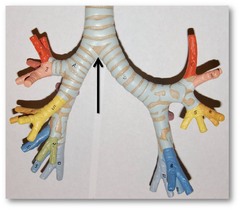
The carina

answer
the point at which the trachea splits into the right and left main stem bronchi
question
The anterior portion of the trachea
answer
composed of strong C-shaped cartilaginous rings that provide support and structure
question
The posterior wall of the trachea
answer
Made up of muscle and is not a rigid structure
question
Bronchi
answer
the two major branches of the trachea; extends from the carina into the lungs
question
Bronchioles
answer
Smaller sections of the bronchi; lined with smooth muscle and mucous membranes
question
When the mucous lining of the bronchioles becomes inflamed and swollen
answer
Severely narrows the diameter of the bronchiole and causes lower airway obstruction (as seen in asthma). The narrowing causes an increase in airway resistance inside the bronchiole, which makes it difficult to move air
question
An increase in airway resistance
answer
Causes the patient to work harder to breathe which may lead to fatigue and failure of the respiratory muscles
question
Leads to cell hypoxia
answer
ineffective and inadequate ventilation and oxygenation
question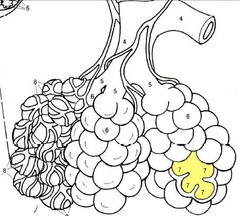
Alveoli

answer
Tiny air sacs in the lungs
question
Pulmonary capillaries
answer
a web of thin-walled capillaries that wrap the alveoli; the site of gas exchange
question
The composition of the lungs
answer
elastic tissue
question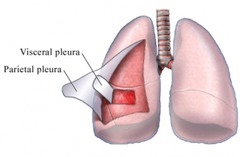
The pleura

answer
The two layers of connective tissue that surround the lungs
question
The visceral pleura
answer
the innermost covering of the lung
question
The parietal pleura
answer
thicker, more elastic layer that adheres to the inner portion of the chest wall
question
Between the two pleura layer
answer
the pleural space; at negative pressure
question
Serous fluid
answer
acts as a lubricant to reduce friction in the pleura space
question
The diaphragm
answer
muscle that separates the chest cavity from the abdominal cavity; major muscle used in breathing; responsible for 60-70% of the effort of ventilation
question
Ventilation
answer
Passage of air into and out of the lungs; creates pressure changes in the lungs to draw air in and force air out
question
Inhalation/inspiration
answer
breathing air in
question
Exhalation/expiration
answer
process of breathing air out
question
Inhalation mechanics
answer
diaphragm and the external intercostal muscles contract; increases the size of the chest cavity, creating negative pressure inside the chess cavity; active process
question
Exhalation mechanics
answer
Diaphragm and external intercostal muscles relax; reduced chest cavity size; positive pressure; forces volume of air out of the lungs; passive
question
Control of Respiration
answer
The respiratory organs do not have the ability to control their function from within the respiratory system; respirations are controlled by the nervous system
question
The response to an increase level in arterial blood
answer
The chemoreceptors sense the increase and the brainstem sends impulses to the respiratory muscles to increase the rate and depth of respiration
question
The main stimulus for breathing in healthy people
answer
Carbon dioxide
question
Hypercarbic drive
answer
What healthy people breath
question
The difference between COPD people and normal people
answer
In people with COPD the carbon dioxide level in arterial blood is typically chronically elevated as a result of the disease process. Because of the constant high carbon dioxide level the chemoreceptors become relatively insensitive to changes in carbon dioxide. Instead the chemoreceptors in COPD patients tend to rely on oxygen levels in the blood to regulate their breathing.
question
Why do COPD people breath?
answer
To increase their oxygen levels instead of decrease their Carbon dioxide level
question
Oxygenation
answer
the process by which the blood and the cells become saturated with oxygen
question
Internal respiration and external respiration
answer
the process in which fresh oxygen replaces waste carbon dioxide, a gas exchange that takes place between the alveoli and the capillaries in the lungs, and between the capillaries and the cells throughout the body
question
Hypoxemia
answer
Low oxygen content in arterial blood. Typically occurs from a ventilation-perfusion mismatch
question
Ventilation-perfusion mismatch
answer
occurs when there is a lack of available oxygenated air in the alveoli even though perfusion (blood flow) to the alveoli is adequate or when the alveoli are adequately oxygenated but perfusion to the alveoli is poor or when there is a combination of both poor ventilation and poor perfusion in the alveolar-capillary structures
question
Other causes of hypoxemia
answer
inadequate ventilatory drive, anemia, and carbon monoxide poisoning
question
Hypoxia
answer
inadequacy in the amount of oxygen being delivered to the cells
question
Different causes of hypoxia
answer
Occluded airway, inadequate breathing, inadequate breathing, inadequate delivery of oxygen to the cells by the blood (hyper fusion or shock), inhalation of toxic gases, lung and airway deceases, etc
question
Signs of Mild to Moderate Hypoxia
answer
Tachypnea (increased respiratory rate) Dyspnea (shortness of breath) Pale, cool, clammy skin (early) Tachycardia Elevation in blood pressure Restlessness and agitation (from hypoxic brain cells) Disorientation and confusion (from high CO2 levels) Headache
question
Signs of Severe Hypoxia
answer
Tachypnea Dyspnea Cyanosis Tachycardia that may lead to dysrhythmias and eventually bradycardia Severe confusion Loss of coordination Sleepy appearance Head bobbing with droopy eyelids Slow reaction time Altered mental status Seizure
question
Cyanosis
answer
a bluish gray color, a late sign of hypoxia and may be found in and around several areas including the lips, mouth, nose, fingernail beds
question
Gas content of the blood entering the capillaries
answer
High oxygen content and a low carbon dioxide content
question
Causes of disruption in the mechanical process of pulmonary ventilation
answer
•Interruption of the nervous system's control and stimulation of the diaphragm or of the external intercostal muscles •Structural damage to the thorax may interfere with the bellows action of the chest. This will impede the ability of the thorax to generate pressure changes necessary to draw air into the lungs for inhalation and to allow airflow out of the lungs during exhalation. Pain associated with chest injury, flail chest (two or more ribs fractured in two or more places), rupture or injury to the diaphragm, or compression of the chest wall can reduce the effective bellows action of the chest •Increased airway resistance will reduce airflow through the respiratory tract and reduce the amount of air in the alveoli. This will make less oxygen available for gas exchange. An increase in airway resistance may occur from bronchoconstriction or from inflammation inside the vessel •Disruption of airway latency can occur from swell in caused by infection, allergic reaction, or burns; from trauma; from foreign body obstruction; or from loss of muscle tone associated with an altered mental status or unresponsiveness. Reduction or loss of airway latency will reduce the tidal volume, minute ventilation, alveolar ventilation, and volume of gas in the lungs for gas exchange
question
The mouth and nose of children
answer
The noses and mouths of infants and children are smaller than those of adults; thus it is especially important to keep the nose clear of obstructions
question
The pharynx of children
answer
The tongue of an infant or child is relatively large in proportion to the size of the mouth.
question
The trachea and lower airway of children
answer
Narrower, softer, and more flexible than adults. Airway obstructions occur more easily from mucus, pus, blood, secretions, swelling, constriction, and kinking of the trachea with flexion or extension
question
Chest wall in children
answer
Softer and more pliable than in an adult; leads to greater compliance during ventilation
question
Patent airway
answer
open airway
question
Functions and considerations regarding the airway
answer
•the airway and respiratory tract is the conduit that allows air to move from the atmosphere and into the alveoli for gas exchange •No matter what the patient's condition, the airway must remain patent at all times •Any obstructions of the airway will result in less air movement, which will lead to some degree of poor gas exchange and potential hypoxia •The degree of the obstruction will directly affect the amount of air available for gas exchange. The tongue may create only a partial airway obstruction, whereas a piece of food may completely stop airflow
question
A patient's mental status typically correlates to the status of his airway
answer
An alert, responsive patient who is talking to you in a normal voice has an open airway. A patient with an altered mental status or who is completely unresponsive connote adequately protect his own airway.
question
Signs of an open airway
answer
1) air can be felt and heard moving in and out of the mouth and nose 2) the patient is speaking in full sentences or with little difficulty 3) the sound of the voice is normal for the patient
question
Snoring
answer
occurs when the upper airway is partially obstructed by the tongue or by relaxed tissues in the pharynx.
question
Crowing
answer
sounds like a crow cawing that occurs when the muscles around the larynx spasm and narrow the opening into the trachea, air rushing through the restricted passage causes the sound
question
Gurgling
answer
sounds like gargling, usually indicates the presence of blood, vomitus, secretions, or other liquid in the airway
question
Stridor
answer
a harsh, high-pitched sound heard during inspiration, characteristic of a significant upper airway obstruction from swelling in the larynx, may also be heard if a mechanical obstruction by food or other object is presence
question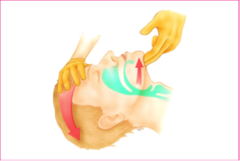
Head-tilt, Chin-lift maneuver

answer
no spinal injury
question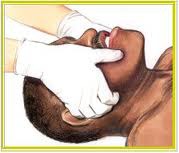
Jaw-thrust maneuver

answer
suspected spinal injury
question
Standard precaution during suctioning
answer
Protective eyewear, a mask, and gloves. If a patient is known to have TB an N-95 should be worn
question
Suction Equipment
answer
The device that creates the suction and the catheters
question
Mounted Suction Devices
answer
On-board the ambulance, should be powerful enough to provide an airflow of ;40 lpm and create a vacuum of more than -300 mmHg
question
Portable Suction Devices
answer
Should be capable of generating -300 mmHg of pressure when the suction hose is clamped. A pressure of -80 to -120 mmHg is generally necessary to provide adequate suction. Can be electric, oxygen, air or hand powered
question
Hard or rigid catheter
answer
Rigid plastic tube; Yankauer catheter or the tonsil tip. Used to suction the mouth and oropharynx of an unresponsive patient. Only be inserted as far as you can see and no farther than the back of the tongue.
question
Soft catheter
answer
Flexible tubing; also called the "French" catheter. Used in suctioning the nose and nasopharynx and in other situations where the rigid catheter can not be used. Length should be determined by measuring from the tip of the patient's nose to the tip of the ear
question
Special considerations when suctioning
answer
•If the patient has secretions or vomitus that cannot be removed quickly and easily by suctioning, the patient should be log rolled onto his side and the oropharynx cleared by finger sweeping the foreign material out •If the patient needs artificial ventilation and is producing frothy secretions as rapidly as suctioning can remove them, apply suction for 10 seconds, provide positive pressure ventilation with supplemental oxygen for 2 minutes, then apply suction for another 10 seconds.
question
Two types of artificial airways
answer
Oropharyngeal and nasopharyngeal
question
Points to keep in mind when using artificial airways
answer
1) adjunct must be clean and clear of obstructions 2) proper size must be selected 3) airways adjuncts do not protect the airway from aspirations of secretions, blood, vomitus, or foreign substances 4) the mental status of the patient will determine if an adjunct can be used
question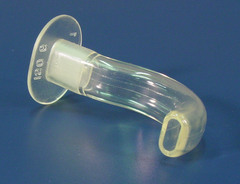
The oropharyngeal airway (OPA)

answer
Patient must be completely unresponsive and have no gag or cough reflex. Measure the airway by holding it next to the patient's face, should extend the distance from the corner of the mouth to the tip of the ear
question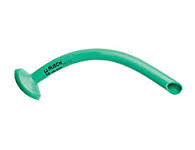
Nasopharyngeal airway (NPA)

answer
Use in patients whom the oral airway cannot be inserted because of clenched teeth, biting, or injuries to the maxilla or face. Can be used in patients who are not fully responsive and have a minimally intact gag reflex. Measure from the nose to the tip of the earlobe
question
Inadequate breathing leads to
answer
Poor gas exchange in the alveoli and ineffective delivery of oxygen to the cells
question
Determining the adequacy of breathing
answer
Assets the relationship between the volume and the rate at which a patient is breathing
question
Minute volume
answer
Dept and rate; typically correlates with how adequately the patient is breathing
question
Tidal volume
answer
Respiratory rate; amount air breathed in and out in one normal respiration
question
Alveolar ventilation
answer
Amount of air breathed in that reaches the alveoli
question
Dead air space
answer
Anatomical areas in the respiratory tract where air collects during inhalation but no gas exchange occurs
question
Minute volume
answer
Tidal volume multiplied by rate
question
Amount of dead air
answer
150 mL of the 200 mL breathed in
question
Assessing for adequate breathing
answer
1) look (inspect) chest rise/fall, general appearance, breathing pattern, nostrils 2) listen 3) feel 4) ausculate
question
Rate
answer
12-20 adults 15-30 children 25-50 infants
question
Signs of adequate breathing
answer
Normal respiratory rate Clear and equal breath sounds bilaterally Adequate air movement heard and felt from nose and mouth Good chest rise and fall with each ventilation
question
Rhythm
answer
The pattern is regular
question
Quality
answer
Equal and full bilateral breath sounds. No excessive accessory muscle use
question
Respiratory distress
answer
The patient is working harder to breathe
question
The effects of inadequate oxygen
answer
Brain death in about 4-6 minutes
question
Respiratory failure
answer
When the respiratory rate and/or tidal volume is insufficient
question
Respiratory arrest
answer
Apnea; occurs when the patient completely stops breathing
question
Causes of respiratory arrest
answer
Stroke MI OD Toxic inhalation Electrocution and lighting strike Suffocation Traumatic injuries to the head, spine, chest or abdomen Infection to the epiglottis Away obstruction by a foreign body
question
Agonal respirations
answer
Gasping breath
question
Deciding if you need to ventilate
answer
Inadequate respiratory rate or inadequate tidal volume
question
Positive pressure ventilation
answer
Forcing air into the lungs
question
Methods of artificial ventilation
answer
Mouth to mouth Bag-valve mask (BVM)- 2 person Flow-restricted, oxygen powered ventilation device BVM 1 person
question
3 major considerations when using a device for artificial ventilation
answer
1) must be able to maintain a good seal 2) device must be able to deliver an adequate volume of air to sufficiently inflate the lungs 3) must be a connection to allow for simultaneous oxygen delivery while ventilating
question
Indications of adequate Ventilation
answer
1) tidal volume must be consistent; it must also be sufficient to cause the chest to rise during each ventilation. (Adequate chest rise) 2) The patient's HR returns to normal 3) Color improves
question
Inadequate Ventilation
answer
1) The rate is too fast or too slow 2) Chest does not rise and fall with artificial ventilation 3) The heart rate does not return to normal 4) Color does not improve
question
Atmospheric air concentration
answer
21% oxygen, 78% nitrogen, and 1% carbon dioxide and other gases
question
Preferred method of artificial ventilation
answer
Mouth-to-mask
question
Advantages of mouth-to-mask ventilation
answer
•One EMT can ventilate using the two-handed mask seal technique, achieving a better mask seal •The mask eliminates direct contact with the patient's nose, mouth, and secretions •Use of a one-way valve at the ventilation port prevents exposure to the patient's exhaled air •The method can provide adequate tidal volumes and possibly greater tidal volumes that bag-valve-mask ventilation •Supplemental oxygen can be administer through the oxygen inlet that most pocket masks have in addition to the ventilation port.
question
Disadvantages of mouth-to-mask ventilation
answer
•The make is perceived by some EMTs as having an increased risk of infection •The EMT providing the ventilation my fatigue after a period of time •The device doesn't allow for the highest possible concentration of oxygen to be delivered with each ventilation
question
Volume of Adult sized BVMs
answer
1600 milliliters
question
FROPVD
answer
Flow-restricted, oxygen-powered ventilation device
question
ATV
answer
Automatic transport ventilator
question
CPAP
answer
Continuous Positive Airway Pressure
question
Criteria of CPAP
answer
Awake, alert, and oriented enough to obey commands Able to maintain airway Able to breath and has a RR of ;25 breaths/min Exhibits signs of moderate to severe respiratory distress or failure
question
Indications of CPAP
answer
Congestive heart failure Pulmonary edema COPD Asthma Pneumonia
question
Stoma
answer
Surgical opening in the from of the neck that may be temporary or permanent
question
Complications with patients with facial injuries
answer
1) Blunt injury can cause excessive swelling that may partially or completely occlude the airway. It may be necessary to insert an airway adjunct to establish and maintain the airway. Avoid the use of a nasopharyngeal airway with mid-face trauma. Also, positive pressures ventilation may be needed to force ventilation past the swollen airway. 2) Bleeding into the pharynx may be severe and can cause problems with the airway management. Frequent or constant suctioning may be necessary
question
Signs of a serve partial airway obstruction with poor air exchange
answer
Cough that becomes silent Stridor heard on inhalation Increase in labored breathing
question
D cylinder
answer
350 litters Constant=.16
question
E cylinder
answer
635 litters Constant=.28
question
M cylinder
answer
3000 litters Constant=1.56
question
Indications for Oxygen Use
answer
•Cardiac arrest or respiratory arrest •When a patient is being ventilated via positive pressure •Any signs of hypoxia in a patient with an adequate respiratory rate and an adequate tidal volume •Any patient with an pulse ox reading of less than 94% •Anyone with a stroke, MI, OD, toxic inhalation, suffocation, foreign body obstruction, drowning, asthma attack, allergic reaction and seizure •Any patient with an altered mental status or who is unresponsive •Injuries to any body cavity or CNS component •Multiple fractures and multiple soft tissue injuries •Severe bleeding that is either internal or external •Any evidence of Shock (hypo perfusion) •Exposure to toxins
question
Oxygen Administration Procedures
answer
1. Check cylinder; remove the protective seal on the tank valve 2. Open and shut the cylinder for 1 second to clean it 3. Place the yoke of the therapy regulator over the valve and align the pins. 4. Slowly open the main cylinder valve 5. Attach oxygen delivery device 6. Open the flowmeter 7. Apply oxygen delivery device to patient
question
Nonrebreather mask
answer
High concentration; 15 lpm; 100% oxygen
question
Nasal Cannula
answer
Low concentration; up to 6 lpm; 24-44% oxygen



